#apocalypsis virtual
Explore tagged Tumblr posts
Text
i fucking adore listening to apocalypsis virtual while it’s raining outside. bonus points when i don’t have to go to school the next day
#depreción sonora#apocalypsis virtual#rain music#i want someone to make one of those yt videos where the music is fuzzy and the rain is audible
1 note
·
View note
Text
Guys Who Are Multiple Guys Tournament, Round 1

Hajime
“Hajime is a normal boy but wishes to be something more, then thanks to that he gets tricked into going through surgeries that erases his memories and gives him amazing talents and habilites, pretty much transforming him into another person entirely, called Izuru Kamukura. Izuru ends up being a person that's bored all the time and ends up influencing an apocalypsis alongside the main villain. Later in a virtual world thanks to his planning he ends up amnesiac and the Hajime persona comes back not knowing of his present state not even his talent. Later in the real world, he wakes up remembering everything, both his memories as Hajime and Izuru. He also created an AI that is pretty much a reflection of himself, with Izuru's eye color but Hajime's hair style” - User submission
Pit
“I just think that the fact that Pit accidentally made his own goth evil twin and then named him Pittoo AND befriended him against his will is extremely funny.” - User submission

#danganronpa#hajime hinata#hinata hajime#kid icarus#kid icarus uprising#pit kid icarus#pit kiu#guys who are multiple guys tournament#bloomposting
84 notes
·
View notes
Note
when u get this ask you have to answer with 5 of ur fave songs and then send this ask to 10 of ur fave followers
aw thank u!! I love any excuse to go on about my favorite music lmao, my current favorites are:
the seed- aurora (anything by aurora tbh, shes amazing please listen to her)
morto- o terno
apocalypsis virtual- depresión sonora
leds do japão- cidade dormitório
senso- supercombo
1 note
·
View note
Text
So this morning I watched “On the Head of a Pin” and it was SO GOOD!
Once again, a Destiel moment I wasn’t expecting at all. “I was getting too close to the humans in my charge. You”. Seriously??? Ok I already saw gifs from that scene but I didn’t know it happened in season 4. It’s the fucking first season with Cas and he already has feelings for Dean?? Holy fuck.
One of the reasons I wanted to watch spn was that everything destiel I got till then were gifs and pics from tumblr and shippers’ interpretations, so I was afraid I would be heavily biased, so watching the show I would learn whether destiel was real or not in the early seasons. Holy fuck, I was so naive... virtually every moment with Cas and Dean has strong destiel feelings. I even wonder if the screenwriters were already pouring the idea of the angel in love with Dean just to add more spice to the show (however I must say for now I don’t see Dean having the same feelings for Cas. Anyway that’s normal because in this season angels are really dicks - i.e. Uriel).
Besides the destiel stuff, there were so many things to unpack (WARNING! SPOILERS AHEAD -just in case someone reading this hasn’t watched the show): Anna’s come back! (I really love her); Uriel’s betrayal, Sam strengthening his powers (he fucking killed Alastair!) because he’s drinking fucking demon blood from Ruby! (that moment really shocked me), the fact that Dean was THE FIRST SEAL BROKEN, and now the weight on his shoulders to terminate the apocalypsis AND Lucifer. Like, woah, this episode really had everything.
I also want to say how good is Jensen’s performance, he’s an awesome actor. His performance at the end of the episode (Dean in the hospital bed) was truly heartbreaking.
Then I watched the following episode (It’s a Terrible Life) and it was also very good, actually because it was hilarious and the lack of the overwhelming drama from the previous episode made it very refreshing.
On a side note: I’m loving the show, but I hate how they treat female characters and discard them. I’m very upset after Pamela’s death, she didn’t deserve that.
4 notes
·
View notes
Text
Frankly-Art’s Top 10 Video Games of 2018

Also available to read on my deviantArt!
With every New Year comes another year’s worth of video games to look forward to, and 2019 promise to be a good one in that regard: the release of Kingdom Hearts III is only days away, Piranha Plant and Joker are certain to be innovative and entertaining additions to the Smash Ultimate roster, Animal Crossing is coming to the Switch… and those mark only a small fraction of the many things 2019 has in store for us in terms of gaming. Amid all of this hype, I got to thinking about the varied gameplay experiences I had over the past year; so, I figured this would be as good an opportunity as any for me to reflect on them with a bit of a critical eye and definitively rank each of the video games I managed to get to during 2018!
Keep in mind while reading that, even though this is a list featuring games I played in 2018, many of these games were ones released in years past that I never got around to until last year—so, if you were expecting a list of the top 10 games that were released in 2018, I’m afraid you’ll have to look elsewhere (but not until after you read my oh-so-important list first! I crave validation!); expect a healthy mix of new and old titles in the list below. Additionally, this list will rank downloadable content (DLC) separately from standalone titles, as I don’t find it fair to compare a DLC add-on to a fully-fledged game. I’ll be weighing the score of each DLC depending on how well it improves and expands upon the narrative and gameplay of its original game.
Without further ado (and with no better means of transitioning from this introduction to the list itself than to use a somewhat tired expression in the realm of video games), let’s-a go! (Please forgive me.)
-SPOILER WARNING IN EFFECT-


Favorite Characters: Revali, Urbosa, Kass Favorite Tracks: Monk Maz Koshia (all phases)
It might come as somewhat of a shock that a game with “Breath of the Wild” in its title would rank lowest on my list, but hear me out: no matter how much fun it was to be able to return to Hyrule in this DLC expansion, in my opinion, Champions’ Ballad just felt like more of the same of what we got in the main game.
Despite the nigh perfection that was Breath of the Wild, I have to agree with critics who said that the lack of aesthetic variation between segments of dungeon crawling and puzzle solving was a monotonous bore when compared to the varied themes and aesthetics of the dungeons in Zelda games past, and Champions’ Ballad did nothing to vary the atmosphere in its new shrines and dungeon from those of the main game. This disappointment was compounded with the fact that Champions’ Ballad added no new weapons to your arsenal (aside from a risky-to-use fork that functioned virtually like every other sword in the game) to allow for new types of puzzle solving or exploration. The unicorn motorcycle was certainly a cool reward for completing the DLC (the fact that I got to write the words “unicorn” and “motorcycle” next to each other is reward enough), but I had very little use for it since I’d already combed through the entirety of Hyrule during my first playthrough of the game. I simply believe it would have been nice for Champions’ Ballad to have given players something a little fresher to explore, even if it were just an aesthetic change of scenery.
I had also hoped that Champions’ Ballad might have expanded on the lore sprinkled throughout Hyrule and, even though we learned more about the four champions, I was a little let down that they didn’t really expand on anything else (Why can’t I climb to the top of Mount Agaat? Why does the entirety of the Akkala region fill me with a confusing sense of serene dread?? What the hell happened at the Typhlo Ruins???) I appreciate that, by not explaining everything, Nintendo give players the chance to interpret these things for themselves, but, when compared to the lore provided in previous Zelda games, I feel as though Champions’ Ballad fell short in fleshing out the history of this ruined Hyrule.

Favorite Characters: Prompto, Ignis Favorite Tracks: A Retainer’s Resolve, Apocalypsis Magnatus
Given how much of a beautiful mess Final Fantasy XV was upon its initial release, it’s certainly a consolation to the main game to see how well Square Enix supplemented its (rather disjointed) story and expanded upon its (frankly, lacking) gameplay through its various DLC expansion chapters featuring Noctis’ loyal Chocobros. And while I may not love Ignis quite as much as other chocobros like Prompto or Noctis, Episode Ignis was definitely an engaging and welcome addition to the enigma that is the Final Fantasy XV.
Particular highlights of Episode Ignis include its soundtrack, which features a heroic leitmotif for Ignis that really underscores the dire circumstances he and his teammates find themselves in during this segment of the story, and its addition of gameplay modes (Motorboat Simulator 2018 being one of them) are a welcome change of pace to the somewhat rudimentary battle and exploration systems found in the main game. However, a point of contention I have with Episode Ignis is with its narrative: while I appreciate that this DLC chapter finally explains how Ignis becomes blind, its multiple endings completely undermine the storyline of the main game itself. Does Ignis’ sacrifice save Noctis from having to make a sacrifice of his own in order to save the world? Does Ignis regain his sight after Noctis defeats Ardyn? Do Noctis and Luna finally realize that they’d be better off with other people (as it’s obvious that Noctis is already too preoccupied with his three boyfriends to make room for anyone else)? I need answers, Square!

Favorite Characters: Elizabeth, Atlas/Frank Fontaine Favorite Tracks: Patsy Cline – She’s Got You, Johnny Mathis – Wonderful! Wonderful!
I claimed to be a fan of the BioShock series for so long, even though I’d only ever played the first game in the series until the summer of 2017 when I finally bought a PS4 and, with it, the BioShock Collection. Now, I can call myself a fan of the series without reservation, having explored and discovered all that Rapture and Columbia have to offer. To me, BioShock Infinite: Burial at Sea Episodes 1 & 2 are a love letter to the entire series itself, featuring elements from the three main-series games and tying together each of their narratives (save for maybe BioShock 2, which is absolutely criminal, considering 2 is my favorite game in the series) in a way that, while forced in some aspects, felt like Ken Levine actually cared about clearing up some of the more confusing questions that remained at the end of BioShock: Infinite.
Burial at Sea really came into itself during Episode 2, where gameplay was switched up to feature more fleshed-out stealth mechanics that made sneaking around Rapture and Columbia both exhilarating and terrifying. It was also refreshing to be able to finally take control of Elizabeth, one of the most iconic characters of the series after the Big Daddies of BioShocks 1 and 2, and learn more of her own personal motivations and desires as she maneuvers through hostile environments. As I already mentioned briefly, I know some took issue with the way Burial at Sea wove the first two BioShock games together with the third, but, considering the mess that was made when BioShock Infinite introduced multiverse science into its mythos (and the narrative mess that Infinite was in general—I took great issue with the way they framed the oppressed populations of Columbia as “just as bad” as the ruling populations simply because they used violence to, you know, try and liberate themselves from their oppression), I feel that Burial at Sea did the best job it could considering that the setting of Infinite differed so greatly from that of the first two games.
Also, fun fact: I studied this game as a part of my Master’s Project and played it through a total of three times: once in English and twice in French! Isn’t academia weird?

Favorite Characters: Rando, Buddy, Vega Van Dam Favorite Tracks: 666 Kill Chop Deluxe, He’s My Dad, Brokentooth March
Anyone who reads TV Tropes is likely familiar with the trope “Gameplay and Story Segregation” and its less-frequent counterpart, “Gameplay and Story Integration”. In the case of LISA: The Joyful, this DLC game (which could practically be its own standalone title if it weren’t for the fact Steam labels it as “DLC” and won’t let you play it without first purchasing LISA: The Painful) absolutely excels in the latter and completely subverts the gameplay mechanics and narrative structure of the base game, and this can all be attributed to the way both games focus on your use of the cure-all drug that makes you feel nothing: Joy.
Indeed, where LISA: The Painful makes you question your use of the drug Joy, LISA: The Joyful (Joyful) is nigh impossible to complete without taking it in nearly every battle after you’re left to your own devices when the muscle of your party abandons you. As anyone who’s played the LISA trilogy will know, Joy is a dangerous substance, mutating its addicts and twisting the minds of anyone who uses it, and that Joy is an integral piece of the trilogy’s social and philosophical commentary on the freedom and restriction of choice, the commitment and devotion one carries for a person or cause, and the inherent, inevitable grey area of any and all actions one may take. Despite these themes, LISA: The Joyful is far from a demoralizing experience: if anything, the way the game simulates the feeling of being backed into a corner and the refusal to give up despite the odds only affirms whatever moral code by which you may already live, or is at least an opportunity to feel relief that you yourself aren’t forced to make such drastic decisions for your own survivability and freedom.
That’s it for the DLC games I played in 2018; now, the real fun begins! Brace yourself for my list of the top standalone titles I played last year!


Favorite Characters: Katie
This game was recommended to me by a friend, and, as much as I wanted to enjoy it, this game wound up being my lowlight of 2018, with its simplistic, seemingly rudimentary gameplay and conspicuous lack of any compelling narrative. Put bluntly, this game was like a forgettable rendition of Animal Crossing, only without any cute animal neighbors to run errands for. The game’s environment threatened absolutely no danger to your player character, yet still didn’t offer any engaging or challenging puzzles to solve to make up for this lack of danger (most “puzzles” involved figuring out how to get to a particular point on the map… and that was it). Despite this being an open-world game that offered endless opportunities for customization, I found myself hurrying to complete the game’s main (5-hour) campaign so I could feel justified to move on to other gaming experiences. The most unfortunate part of this to me is that I know there’s still more to the game’s world for me to explore, but I’m in no way compelled to do so.
In all fairness, though, I think that I’m a little older than the target demographic this game was aiming for. This game was never meant to be challenging or stressful, it was made to be a relaxing escape for anyone looking to pass the time exploring and discovering a beautifully modeled and brightly colored world. This game also wins serious points for inclusivity, especially considering the age group this game was most likely made for; my fondest memory of this game is of a quest where a woman requests that you find her the ingredients to make a potion that stimulates beard growth because she wants to grow a beard of her own, and not once during this campaign is she ridiculed or belittled for wanting one. Since Yonder seems to be a game for kids, I believe quests such as this are an excellent step to socializing them into a world that’s less judgmental and more receptive to other people. So, despite my earlier critiques of this game, Yonder would be a great game to consider if you’re looking for a low-key and off-beat (and all-human) alternative to Animal Crossing.

Favorite Veteran Fighters: Peach, Zelda, Zero Suit Samus Favorite Newcomers: Daisy, Ridley, Richter Favorite Stages: Fountain of Dreams, Fourside, Hyrule Temple Favorite Tracks: All-Star Rest Area (Melee), Destroyed Skyworld, Athletic (Yoshi’s Island)
We all knew another installment in the Smash series was coming ever since the Switch was first announced back in March of 2017. In fact, you might even say that the quality of each console’s iteration of Smash reflects the quality of the console itself, with Melee demonstrating the power and potential of the GameCube, Brawl being a gimmicky romp on an equally gimmicky console, and Wii U/3DS (what a title, right?) completely failing to capture player interest for longer than a few rounds of Smash (the Wii U era feels like a fever dream to me at this point). It’s a letdown, then, that with the Switch being such a commercial and technical success, Smash Ultimate seems somewhat of a disappointment when weighed against the hype that surrounded it up until its release back in early December.
It’s true that Smash Ultimate really delivers in regard to the character roster (everyone is here!) and stage selection (almost everything is here!), but the cuts that were made to series staples like trophies, event matches, and the like, detract from Smash Ultimate becoming the be-all end-all title in the series that it could have been. Trophy mode was where I learned much about video game history and was introduced to obscure series I would have never discovered otherwise, and their replacement with spirits feels a bit cheap, especially since spirits don’t come with any kind of information to contextualize them. Event Matches were hybridized with Melee’s Adventure mode and Brawl’s Subspace Emissary, creating the “World of Light”; while the World of Light has grown on me the more that I play it, it’s somewhat discouraging to me that, by combining so many modes of Smash games past into one, there will be nothing left for me to do with the game once I reach its end.
Still, Smash Ultimate offers plenty to look forward to. I’m more-than-hyped about the additions of Piranha Plant and Joker from Persona 5 to the character roster, and I can’t wait to see who might be announced next (unless it’s another Fire Emblem character… please God [Sakurai] don’t let it be another Fire Emblem character).

Favorite Tracks: The Bridge, Touching the Stars, Up to the Nest
I could never have prepared myself for the beautiful-yet-heart-wrenching experience this game would put me through, but I’m oh-so-glad that it did. On the surface, RiME is a relaxing exploration and puzzle game that takes place in a beautifully rendered in-game world, with a brilliantly orchestrated soundtrack and a plethora of diverse landscapes to get lost in. And yet, every moment of your adventure is permeated by an inescapable sense of isolation and dread, making you ask questions like “Where is everyone?”, “Just who is that man in the red cloak?,” and, “Is he stalking me, or are I stalking him?”.
Indeed, RiME’s narrative unfolds wordlessly as you explore and leaves you to discover and interpret on your own exactly what tragedies transpired before the events of the game, tragedies of which are far more poignant and moving if you were to discover them yourself. I know I’ve put a spoiler warning in effect, but I highly recommend you play this game on your own (or at least watch a decent Let’s Play of it) if you’re curious to know what unfolds during the game’s narrative. RiME is a relatively short game, too, lasting only between 5-10 hours, so it would be an easy one to fit into your queue if you’re looking for a fun gameplay experience with a story that will haunt you for weeks and months on end after completing it.

Favorite Characters: Terry Hintz, Buzzo, Wally Favorite Tracks: Men’s Hair Club, The End is Nigh, Summer Love
Having already talked about this game’s DLC expansion of LISA: The Joyful, you’re already aware that I hold the LISA trilogy in high regard—it also means I can make this entry somewhat brief, since a lot of what I said about Joyful can also be applied to its parent title, LISA: The Painful. You see, it’s in LISA: The Painful where the conflict in Joyful begins, and where we learn more of how the world came to be so depraved after the White Flash, an extinction event that inexplicably killed all women on the planet (at least, as far as the characters in the game know). The game considers what the repercussions of such an event would be on our society (aside from dooming humanity to die off within a generation) and really explores the darkest depths of toxic masculinity to call into question the detrimental effects it has on our self-esteem, our relationships, and our will to survive. Gameplay-wise, it’s a fairly traditional JRPG, though as I mentioned with Joyful, LISA: The Painful integrates its story with its gameplay by permanently increasing (but mainly decreasing) your stats depending on whatever injuries you escape or sustain throughout your journey. All in all, LISA: The Painful is a truly harrowing experience from beginning to end, but a must-play for anyone with an interest in the more macabre aspects of human nature.

Favorite Characters: Aloy, Erend, Vanasha Favorite Tracks: Louder
You know a game’s going to be good when its title screen holds you in awe before even pressing start. Imagine a sunlit vignette over purple mountains and a glistening river, a haunting and triumphant melody underscoring it all, as the title slowly fades into view in white in the center of the screen: Horizon Zero Dawn. O.K., I’m in. This game just did so many things right as an open-world game during an era where the genre was oversaturated by mediocre games that rehashed the same tired tropes and mechanics in its gameplay and world building. Horizon Zero Dawn truly set itself apart from the crowd for a variety of reasons: its beautifully detailed setting (being a microcosmic interpretation of Western North America), its intricate combat system with a graciously forgiving learning curve, and its compelling and socially-conscious narrative all worked together to distinguish this game within the open-world genre.
What really sets this game apart most of all, though, is the game’s protagonist, Aloy: a rare female protagonist who is a breath of fresh air in a sea of male heroes, whose capabilities and intellect don’t come at the cost of her physical appearance and femininity. Aloy set an example for other game developers that female protagonists are more than viable (and are in fact, overdue) in the video games of today, and her status as a female character never felt gratuitous or shoehorned (e.g. Battlefield V’s inclusion of a female protagonist as an enlisted soldier in the British Army and serving in the line of duty during World War II). It’s difficult (read: impossible) to play Horizon Zero Dawn and not fall in love with Aloy for her wit, her strength, and her general stick-to-itiveness in the face of adversity (not to mention, she’s just really cute and knows how to work a belly shirt). With Aloy as the protagonist, you’ll never tire of adventuring through Horizon Zero Dawn’s 70-hours+ worth of gameplay as you explore the in-game world to learn just what happened to “The Old Ones” and their society all those millennia ago.

Favorite Party Members: Ryuji Sakamoto, Ann Takamaki, Makoto Niijima Favorite Confidants: Hifumi Togo, Sadayo Kawakami, Sae Niijima, Toranosuke Yoshida, Chihaya Mifune Favorite Targets/Boss Battles: Ichiryusai Madarame, Kunikazu Okumura, Leviathan, Yaldabaoth Favorite Tracks: Blooming Villain, Rivers in the Desert, A Woman, Aria of the Soul
I’ll bet no one saw this one coming! Just kidding—anyone who’s exchanged more than a few words with me since the fall of 2018 knows how much this game absolutely consumed my life over the span of, I don’t know, I think it was four months? Indeed, I wound up sinking a total of 123 hours into this game, and there’s still a loud part of me that wants to return to it to begin a New Game+ (you’ll even notice that it was too difficult for me to contain my favorite characters into one category, instead having to split them up in order to represent all of my favorites because of how much I love them all). I’m already a fan of JRPGs, so it didn’t take much for Persona 5 to win me over with its turn-based combat, but the addition of certain gameplay mechanics—like earning an extra turn for exploiting enemy weaknesses or improving your relationship with your friends outside of battle to unlock gameplay bonuses—prevent battles and exploration in Persona 5 from ever becoming stale. Indeed, Persona 5 was truly a masterpiece from start to finish and an experience that I never wanted to end.
Frankly, any drawbacks I could mention about this game feel almost nitpicky, like the way the status ailment “Envy” is represented during the final boss fight by the color indigo instead of green, or how Kawakami can only manage to make me one cup of very useful, SP-restoring coffee over the course of an entire evening. Still, Persona 5 isn’t without its faults: for one, Persona 5 loses significant points for its questionable representation of LGBT groups (the camp gay men who openly harass Ryuji on multiple occasions being the most glaring example), and this isn’t helped by the queerbaiting that’s prevalent in a lot of character dialogue and relationships. Additionally, the fact that you can’t romance any of your male confidants comes across as erasive at best and homophobic at worst, especially considering that 1) all but one of your female confidants are eligible girlfriends, 2) you can two-time all of them at once if you so desire (which isn’t just disrespectful, it’s also flippantly misogynistic), and, most importantly, 3) one of this game’s main themes includes rebelling against oppressive societal norms (a theme that will resonate deeply with any LGBT+ player). Female representation in Persona 5 is also somewhat of a mixed bag: while the game features a large cast of diverse female characters, its constant and blatant objectification of Ann is not only creepy, it’s incredibly obtuse considering the sexual harassment and abuse she suffers by one of her teachers during the game’s first story arc. Fortunately, each of these drawbacks is easy enough to ignore when discussing the game as a whole, but I hope Atlus improves upon them in future installments: considering how incredible an experience Persona 5 was, imagine how much more incredible Persona 6 could be if these issues were fixed!
So that’s it for my top 10 games of 2018. What are your thoughts? Do you agree or disagree with any of my commentary? What were some favorite games you played during 2018? I’d love to hear your responses and start a discussion, so please, leave your comments in the notes!
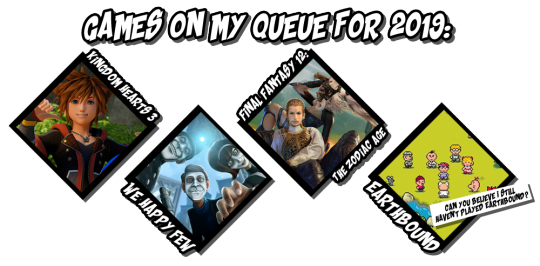
#my post#blog#journal#deviantart#video game#video games#new year#new year's#zelda#the legend of zelda#breath of the wild#final fantasy#final fantasy xv#episode ignis#bioshock#bioshock infinite#LISA: the joyful#LISA#Yonder#yonder the cloud catcher chronicles#smash#smash ultimate#super smash bros ultimate#RiME#LISA: The Painful#Horizon Zero Dawn#HZD#Persona#Persona 5#Kingdom Hearts 3
6 notes
·
View notes
Text
NDRV3: Apocalypsis [REWORKED]
read it on the AO3 at https://ift.tt/3zKPxPE
by bandsaw
[THIS IS A COMPLETE REWRITE OF MY FORMER FIC APOCALYPSIS, WHICH HAS BEEN DELETED]
Finally free from the trials and tribulations of the killing game, the three survivors are ready to leave the cage they've been trapped in for so long... only to wake up in another. With the apocalyptic meteorites they'd all prayed were simply lies are revealed to have already crashed down, it's up to them to fend for themselves and survive, all while uncovering the mysteries of the nightmare they were locked into.
People thought dead still live, and the situation at hand is sure to test the limits of an already broken group even more. Not even their own memories are trustworthy, as everyone is forced to uncover the real truths regarding the lives they lead before the killing game. __ an exploration of the characters and plot of V3, hoping to expand on what little we got and make sense of the admittedly batshit plot, all while tossing the gang into a brand new situation and working through what the killing game has left behind. - owl
Words: 2151, Chapters: 1/?, Language: English
Fandoms: New Dangan Ronpa V3: Everyone's New Semester of Killing
Rating: Teen And Up Audiences
Warnings: Creator Chose Not To Use Archive Warnings
Categories: Multi
Characters: Saihara Shuichi, Harukawa Maki, Yumeno Himiko, K1-B0 (Dangan Ronpa), Amami Rantaro, Akamatsu Kaede, Tojo Kirumi, Hoshi Ryoma, Chabashira Tenko, Yonaga Angie, Gokuhara Gonta, Iruma Miu, Momota Kaito, Oma Kokichi, korekiyo isn't here bc he's dead and i dont wanna write him, tsumugi is important but will only be mentioned
Relationships: Momota Kaito/Oma Kokichi, Gokuhara Gonta/Hoshi Ryoma, Akamatsu Kaede/Saihara Shuichi, all of these are eventual ships and not the main focus of the work, others may be added or adjusted
Additional Tags: Alternate Universe - Apocalypse, Post-Canon, Killing Game Was A Virtual Reality Simulation (Dangan Ronpa), Disabled Characters, Autistic Gokuhara Gonta, Autistic Yumeno Himiko, Angst with a Happy Ending, It Gets Worse Before It Gets Better, Post-Canon Fix-It, Hurt/Comfort, more tags will be added later <3, Slow Burn, literally all of the ships will be the slowest of slow burns lol, Everyone Needs Therapy
read it on the AO3 at https://ift.tt/3zKPxPE
0 notes
Text
Hello. It’s been awhile.. and I’m finally writing again
Hereby lies my overflowing thoughts of my journey in my 3rd year of studying composition & arranging at Lasalle College of the Arts. Hereby i present to you my logbook. I hope it’s interesting to read..
SEMESTER 1
WEEK 2 || Monday, 7th September 2020
note: Lesson 1 started at Week 2 in 2020.
Topics:
Review of Harmonic Landscape
Advanced Modulation
HARMONIC VOCABULARY
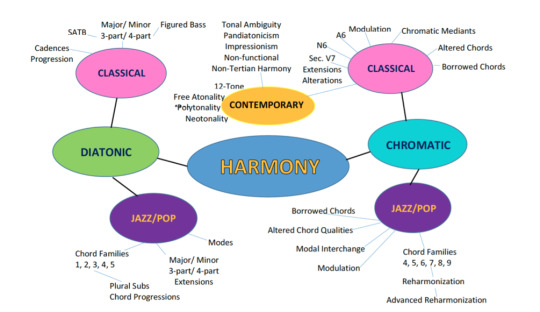
(Belinda Foo. Lasalle College of the Arts 2020)
ADVANCED MODULATION
refer to Max Reger’s text on Modulation
Some key concepts;
No Enharmonics
All modulations approached via cadence-like progressions
Observations;
The modulations are ‘logical’ and can be accountable via tonal relationships
All modulations are arrived at cadentially: IV – V – I, II – V – I, bII – Ic – V – I
It is easier to work out the modulations ‘backwards’ from the dominant of the new key
Relationships between Keys
Pivot chords
Borrowed chords
Neapolitan 6th chords (especially for remote modulations)
Dorian 6th chords (E.g. D major triad in A minor)
2nd super-dominant (E.g. D major triad in C Major)
REVIEW ADVANCED REHARM
Review Menu of Chord Choices
Using Outer Line Movement: Directional interaction between Melody and Bass line
Contrary Motion
Parallel Motion
Chromatic Movement
Tonal Movement
Tritone Movement
Pedal Point
Free Bassline
Contrary Motion

Parallelism
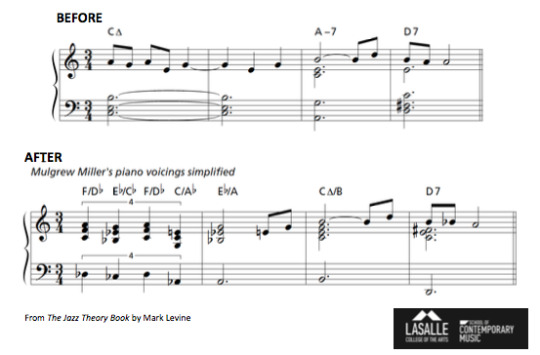
Chromatic Movement
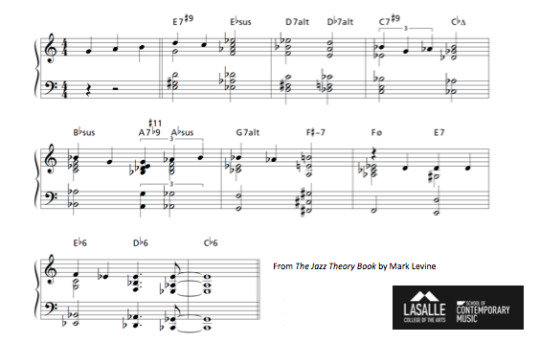
Tonal Movement
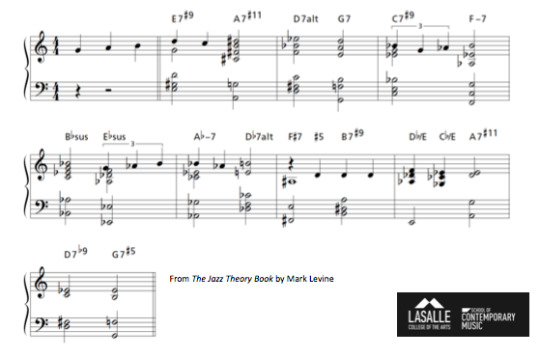
Tritone Movement
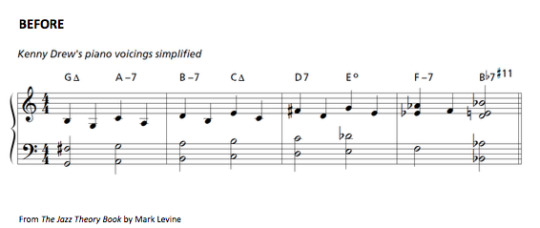
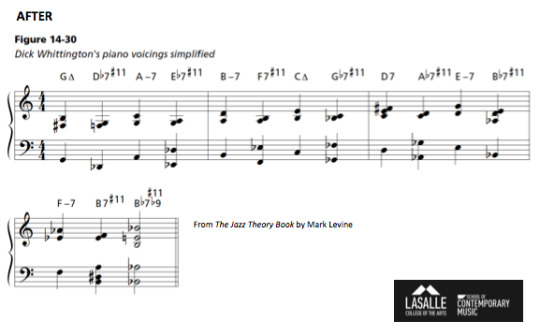
Pedal Point
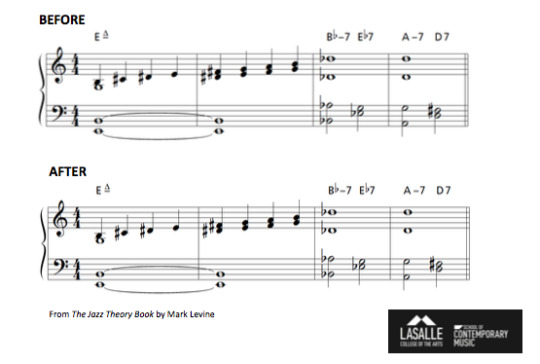
Free Bass line

Use of Polychords
C Major triad over Bb7
F# Major triad over A7
Bb Major triad over D7

Use of Minor 11th Shapes:
Open 4th at the bottom
Triad (2nd inversion) at the top
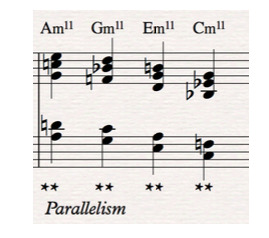
————————————————————————————— WEEK 3 || Monday, 14th September 2020
In week 2, Belinda discussed the same topics from Week 1 because we had not yet covered everything last week. My summary from this week is concluded in week 1 as it is also pretty much the same from last week. Belinda also further talked about Max Reger’s techniques.
Topics:
Review of Harmonic Landscape
Advanced Modulation
————————————————————————————— WEEK 4 || Monday, 21st September 2020
In week 3, Belinda further talked about Max Reger’s modulation again. The summary for this one is also included in my week’s 1 summary. Other than that we discussed about Romantic and Late-Romantic music, Wagner’s Lohengrin, and writing for strings.
Topics:
Max Reger Modulation Review
Romantic & Late-Romantic Orchestration
Analysis of Wagner’s Lohengrin
Writing for Strings
ROMANTIC MUSIC PERIOD
basic information:
From about 1830 to 1900
Characteristics: expressive, expansive, virtuosic, inspired by art, literature
New forms beyond the Classical forms, such as: rhapsody, arabesque, song cycle, nocturne and programmatic music
Greater Chromaticism
Extended melodic lines, themes
Romantic Composers
Berlioz, Hector
Brahms, Johanne
Bruckner, Anton
Chopin, Frédéric
Dvorák, Anton
Grieg, Edvard
Mahler, Gustav
Tchaikovsky, Peter
Strauss, Richard
Wagner, Richard
Relevance of Romantic Music Today
Melodies and Harmonies still used in Film & Animation music
Leitmotif: a theme associated with a character, place or idea
Orchestration: Romantic Orchestra & Orchestral techniques
COMPOSING FOR STRINGS
Characteristics of the Strings Family;
Homogenous timbre throughout the family
Virtually tireless for both player and listener
Flexible, versatile in terms of register and ability
Writing for Strings Masterclass:
link: https://www.youtube.com/watch?v=yST6mS8W1f8&ab_channel=JeffPifher
personal note:
This was actually a homework from previous week from Belinda, and i watched the video beforehand. There were some key takeaways to make writing for strings more interesting like (which are actually unbelievably so simple) ;
- “know what to look for” — pay attention to your melody, style, phrasing - playing with texture (e.g. one line playing staccato, another line playing legato/long lines) - accents!!! — articulation is key!!!
The Strings Choir as:
Foreground
Middleground
Background
Homophonic Writing
Accompanying Choir
Contrapuntal Textures
Special Effects and other 20th Century devices
String Section Sizes

General String Writing Tips
Divisi: divides the section, used to add/ complete harmony. Div a 2, Div a 3, Div a 4 (not common). Not a good idea to divisi violas if they are less than 8 players (6 players minimum)
Double stops: most commonly used to add harmony part. Stick to slow moving passages. Check that the double stops are feasible on the instrument.
Pizzicato: Best kept to the lower 3 strings
Octave combinations: It is common practice to double very high violin lines (Violin 1) an octave lower (Violin 2) to lend the former support.
Bowing Effects
Belinda asked us to refer to this video, which I also watched before the class as it was part of our homework from last week.
link: https://www.youtube.com/watch?v=cEBN2UkJavk&ab_channel=VIOLINLOUNGE byViolinistZlata
ANALYSE WAGNER’S LOHENGRIN PRELUDE 1
note;
during this analysis, our main focus was the string writing, string choir: homophonic writing primary line against accompaniment
link: https://www.youtube.com/watch?v=gT1AfIUgO88&ab_channel=ClassicalMusicScores
—————————————————————————————
WEEK 5 || Monday, 28th September 2020
Topics:
Max Reger Modulation Review
Writing for Woodwind
Analysis of Wagner’s Rienzi
MAX REGER MODULATION REVIEW
This week, Belinda reviewed about the Max Reger modulation. The summary is pretty much the same with the previous weeks we had it.
WRITING FOR WINDS
Characteristics of the Wind��Family
Less homogenous in sound (unlike the Strings)
Single reed and double reed timbres differ
Wind players need to take breath
Some Interesting Effects
Double-tongueing/ Triple tonguing
Harmonics - The pitch of the harmonic sounds exactly as it is notated
Fluttertongue - Flautists flutter their tongues to create a “frrr,frrr” sound
personal note;
because of the lessons and workshops I had from Felix’s class (Specialized Ensemble Workshop), these effects were no strangers to me and I am quite familiar with it. I have also used these effects in my composition (mainly in his class). But this lesson was a good refresher to me.
Common Functions
Harmonic background - Homophonic wind writing
Solo passages - Choice of timbre/colours
Contrasting colors - To repeat or echo; create relief
Double other instruments - add richness, warmth; brighten up
Contrapuntal Writing
The unique color of each wind instrument makes for ideal contrapuntal writing
Refer to Britten’s The Young Person’s Guide to the Orchestra, Fugue, mm 1-55
Refer to Stravinsky’s Rite of Spring, “L’Adoration de la terre” mm 40-60.
Special Effects and other 20th Century devices
Belinda showed us some pieces that has examples of special effects. The pieces we discussed were;
1. Penderecki, Dies Irae “Apocalypsis” mm 2-4
Winds first play the highest pitch they are able to produce. Then they trill on the specified notes until the end of the dark line with arrow.
2. Stachowski, Irisation for Orchestra, third movement, mm. 79-83
The composer asks the winds to remove their mouthpieces from their instruments and “play through them.
ANALYSES OF WAGNER’S RIENZI
note:
during this analysis, our main focus was the woodwind writing, homophonic writing, choice of color,relief, highlights, adding warmth, and color
—————————————————————————————
WEEK 6 || Monday, 5th October 2020
Topics:
Writing for Brass
Analysis of Wagner: The Flying Dutchman
WRITING FOR BRASS
Characteristics of the Brass Family
Most powerful sound resource in the orchestra
Not as homogenous in sound as the strings although horns and trombones can blend fairly well
Not’ tireless’ on players and listeners — the brass sound is an imposing one and players need to breathe
Common Functions
Homophonic Unit
Pay attention to voicing, spacing, voice-leading and doubling
Refer to overtone series
Strengten and clarify harmony
Reinforcing harmony played by another choir
As a pedal
Harmonic ‘glue’, background line
State a melody
Choice of timbre, dynamics
Combinations
Double other instrument(s)
To add colour
add weight, power
Build Climaxes
Hold back first, save the colour for climactic event Contrapuntal voice
Use instruments in their best register — clarity go line and balance
Pay attention to timbral differences and articulation
refer to Stravinsky’s J.S Bach Choral Variations, Var. IV, mm. 1-6
Special Effects in Brass
refer to “Contemporary French Horn Techniques - Guide for Composers”
link(s):
https://youtu.be/_FPDrQzRE3o
https://youtu.be/-IwXEyr4uV8
https://youtu.be/qQ1oe3YSqsY
ANALYSIS OF WAGNER’S “THE FLYING DUTCHMAN”
note:
In this analysis, our main focus was the brass writing, choice of color, and orchestral combinations.
another note (not important); everytime i hear the word Flying Dutchman, it reminds me of the movie Spongebob Squarepants :))))). The Flying Dutchman is the ghost that Spongebob and citizen of bikini bottoms most feared of
—————————————————————————————
WEEK 7 || Monday, 12th October 2020
Topics:
Motivic/Thematic Development
Orchestral Devices
Analysis of Holst’s Mats, Mercury, Venus
MOTIVIC DEVELOPMENT
Repetition
Sequence
Changing intervals
Fragmentation
Extension
Inversion
Changing the rhythm
Decorated repetition
Changing order of notes
Augmentation
Diminution
Contraction
Expansion
personal note:
Belinda showed us examples (played it on her keyboard) of motivic development by playing a short motif and expand it by using the devices above. It is such a simple idea yet so useful and i foresee myself using these techniques many times because of the very little amount of time i’ll be having to write for my recital. a.k.a squeezing juice out of my brain!!!
THINKING ORCHESTRALLY
Basic Concepts
Balance
Sonority
Unity, Variety
Tone/ Timbral colour
Clarity, Brilliance
Expressiveness
Orchestral Textures
Orchestral Unison
Melody and Accompaniment
Primary and Secondary Element(s)—Melody, secondary line(s), accompaniment
Part Writing
Isolated Chords
Complex Texture
ORCHESTRAL DEVICES
String Quartet & Wind Quintet
Within Family timbres
Solo feature
Combination of timbres
Tutti unison
String devices; bowing techniques (detaché, legato, marcato, staccato, spiccato, au talon, Punta d’arco), Pizzicato, tremolo, col-legno, sul ponticello, glissandi/portamenti, harmonics
Wind devices; Double-triple tonguing, flutter tonguing, harmonics, slap-tongue
Brass devices; mutes, stopped, double-triple tonguing, glissandi, bells up (horns)
Percussion; Types of Percussion— pitched, unpitched, Metal, Wood, Non-metal, Membranous, Keyboard
ANALYSES OF HOLST’S “MARS”, “MERCURY, and “VENUS”
note;
during this analysis, we focused on the choice of color, orchestral combinations, and motivic/thematic development
personal note; i love love love uncle Holst so much. I wish i wrote his pieces. Some of his pieces from The Planets series also has become my inspirations in writing my recital pieces!
—————————————————————————————
WEEK 8 || Monday, 19th October 2020
Topics:
Review Compositional Devices
Analysis of Holst’s Mercury, Venus, Jupiter, and Uranus
COMPOSITIONAL DEVICES
remember remember remember this!
Common Practice Tonal Centers — Major and Minor
Chord Extensions — 9ths, 11ths, and alterations
Added note chords
Chromaticism and Tonal Ambiguity
Meter-Mixed and Asymmetrics Meter
Modes and other Scale sources, including Synthetic scales
Pandiatonicism
Polyharmony—Polytonality and Polychords
Non-Tertian Harmony — Quartal and Quintal
Scandal Chords — clusters
Parallelism
12-tone Technique and Serialism
Limited Composition—based on intervals
Hexachord Writing
Unrelated Triads
Neotonality
Mirror Writing
Harmonic Direction; Progression, cadential services
Harmonic Synthesis
Indeterminate Procedures
NEOTONALITY
basic information;
Tonality that is not based on any particular diatonic system nor functional harmony (Common Practice Period)
Features non-traditional concepts such as tonal assertion or contrapuntal movement around a tonal centre (which may shift).
Combining the features of Common Practice Period tonality with 20th Century tonal ambiguity and atonal characteristics
Neo-tonal Composers
Paul Hindemith
William Schuman
Roy Harris
Samuela Barber
Vaughn Williams
Sergei Prokofiev
Igor Stravinsky (Neo-Classical pieces)
ANALYSIS OF HOLST’S MERCURY, VENUS, JUPITER & URANUS
i love holst’s piece because it sounds like a film score!
Mercury
The Winged Messenger
Energetic, momentum
Changing tonalities-darting from key to key
Rhythmic & Metric ambiguity
Venus
Bringer of Peace
Woodwinds — overlapping winds, tertian harmonies, sweet
Twinkling effect — 2 harps, glockenspiel
Lines —lower strings
Jupiter
Jollity
Full of beautiful themes, melodies
Use of Timpani
Syncopation
Uranus
Rotates on its side (axis is different from other planets
‘Lop-sided feel’
Strong motif: G-Eb-A-B
personal note:
my favorite is probably the Jupiter piece. It has also become an inspiration for my recital pieces. The sounding-like-film also very much suits my style!
—————————————————————————————
WEEK 9 || Monday, 26th October 2020
Topics:
Review Compositional Devices Pt.4
NEW: Media Music
REVIEW COMPOSITIONAL DEVICES
My summary would be pretty much the same from last week
MEDIA MUSIC
basic information:
Music that is written for film, TV, animation, games, commercials, web applications with the intention of enhancing the production or product.
Practicalities to Note
Specificity of usage
Duration, mixes
Open-ended (looped), Closed-fixed duration
Style, Concept
Target Audience
Functions of music in Media
Commenting
Illustrating Movement
Enhancing Momentum
Create Atmosphere
Portray Emotions
Social/Cultural/Geographical references
Time/Period references
Connects scenes and montages
Alternate the perception of time
Imply a sense of space
Create unreal situations
Create contradictions
Physiological Conditioning
Imply size relationships
—————————————————————————————
WEEK 10 || Monday, 9th November 2020
Topics:
Serial & Atonal Counterpoint
Counterpoint in Hindemith, Bartok, and Stravinsky
Chapter 27 &28 Harold Owen, Counterpoint
SERIAL & ATONAL COUNTERPOINT
during this discussion Belinda showed us examples from;
Schoenberg, No.4 from Five Piano Pieces OP. 23
Webern, Variations for Piano Op. 27, Movement II
Things to pay attention to were;
Texture
Cohesion
Use of Dissonance & Consonance
Temporal Elements,Rhythm, Pulse, Meter
Canonic Qualities
HINDEMITH, BARTOK, AND STRAVINSKY COUNTERPOINT
Belinda showed us examples from these pieces;
Hindemith, Fuga Quarta in A, Ludus Tonalis
Bartok, Theme and Variation from Mikrokosmos, Book IV
Stravinsky, Great Chorale from L’Histoire du Soldat
we also discussed about the things noted below;
Hindemith
Compare the melodic style of hindemith’s fugue with Schoenbrg’s piece
Describe the vertical sonorities, cadences, and treatment of the major triad
Describe the temporal aspects in Hindemith’s fugue and compare them with Schoenberg and Webern
Bartok
What is the tonal centre of this piece?
Describe the melody in this example
What are the intervallic relationships?
Explain the significance of ‘Theme & Inversion’
How are the parts related and yet maintain their independence?
Discuss the rhythmic treatment
Stravinsky
How does the ‘Great Chorale’ resemble a Bach Chorale?
What key is this chorale in? Describe the cadences.
There is liberal use of chromaticism, yet the voice-leading is diatonic. Explain this.
There are triads in the harmony. Discuss how they are used here in comparison to music of the Common Practice Period.
—————————————————————————————
WEEK 11 || Monday, 16th November 2020
Topics:
Review Series & Atonal Counterpoint
Passacaglia writing
Creating Harmonic & Textural Worlds
REVIEW SERIES & ATONAL COUNTERPOINT
Discussed the same thing from last week, and Belinda discussed the things she has not yet covered, making the topic more in-depth. My summary for this is the same from last week.
PASSACAGLIA WRITING
What is Passacaglia form?
Passagcalia is a musical form of continuous variation in triple time. It was a courtly dance that originated in Spain in the 17th Century.
The passagcalia usually begins with an ostinato in the bass, but is also found in other voices.
How to write a Passacaglia?
Begin with a ’tonal’ line that will work well as a repeated pattern
Variation is created as other lines are layered over/ under this repeated pattern
This initial theme can be sequenced, but it should not be modified too much
The initial theme should always be present in at least one of the voices
Famous Passacaglias include:
Bach- Passacaglia and Fugue in C minor for Organ, BWV 582
Ravel- Piano Trio in A minor, III. Passacaille
Copland- Passagcalia for Piano (1921-22)
Hindemith- Passagcalia, Noblissima Visione Suite
William Schuman- Symphony No. 3
Things discussed;
How is the initial theme repeated, varied?
How are layers added?
How is the theme sequenced?
How are dissonances and consonances manipulated?
Observe density and contour
Observe textural changes
—————————————————————————————
WEEK 12 || Monday, 23rd November 2020
Topics:
CONSULTATION FOR HALF RECITAL
General Types of Musical Material
CONSULTATION FOR HALF RECITAL
For my consultation, I showed Belinda my first draft of my first piece from my recital, titled “The Bushfire, The Flood, and The Virus”
GENERAL TYPES OF MUSICAL MATERIAL
Unaccompanied melody
Unified harmony
Composite harmony
Imitative counterpoint
Similar Counterpoint
Contrasted Counterpoint
Composite musical material
Unaccompanied Melody
Solo
Doubled Unison
Doubled at the Octave(s)
Tutti Unison
Unified Harmony
All parts move in the same rhythm
May be minor, incidental rhythmic differences
Uniform tone-quality
example;
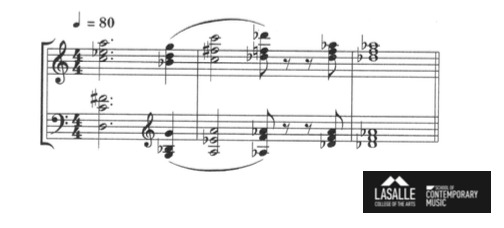
with some minor, incidental rhythmic differences;
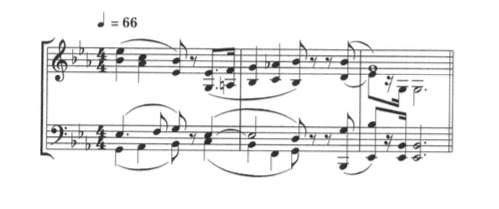
Composite Harmony
2 or more chordal components are layered, each harmonically completely alone
May be treated as harmonically unified or composite
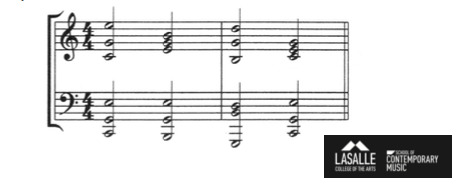
a large vertical distance between the 2 shapes divides it into 2 parts. The harmonic effect is divisive.
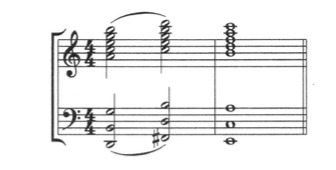
The contrary motion of 2 simultaneous chordal units: produces the effect 2 constituent harmonic units
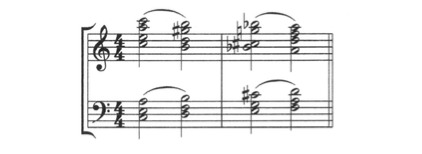
The presence of 2 or more chordal units, with independent rhythms

The effect of unified or divisive harmony depends on these factors:
Tone-quality: the use of a single tone-quality or similar tone-qualities will produce a unified effect
Direction: parallel movements tend to be more unifying than contrary motion
Common rhythms are unifying
Large distances between harmonic units have a divisive effect
Imitative Counterpoint
This involves canonic situations.
To bring out the relationship of imitative parts, one tone-quality should be used.
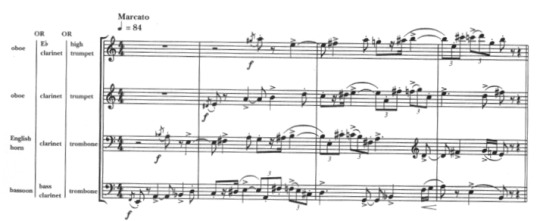
‘Similar’ Counterpoint
This is non-canonic counterpoint.
The parts are related by common rhythmic and intervallic ingredients
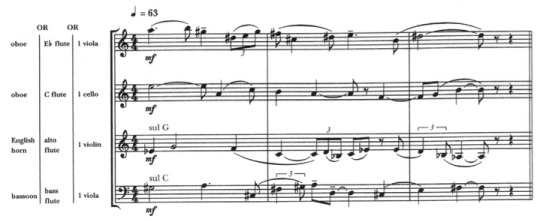
Contrasted Counterpoint
The lines are have noticeable differences in intervals and rhythms
The differences may be accentuated with the use of different timbres

Composite Music Material
A melody with its own rhythm, accompanied by unified harmony in another rhythm, plus composite harmonic interjections:

next example; Imitative counterpoint (piccolo & clarinet) superimposed on unified harmony (strings) in contrasted rhythm, plus a bass line (tuba) in a different rhythm.
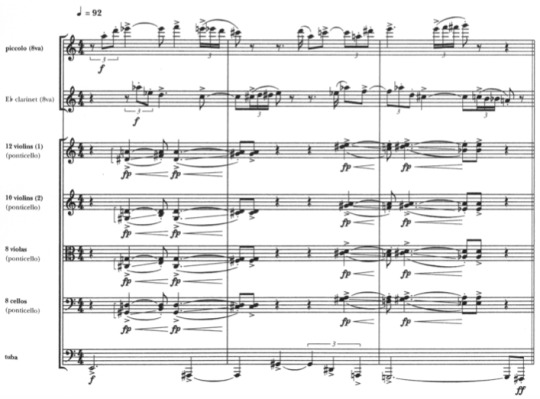
Next example: Composite harmony- violins & violas in 1st group, cellos & basses in 2nd group- enclosing a 2-part ‘similar’counterpoint (2 horns), whose rhythm is different from the harmony.
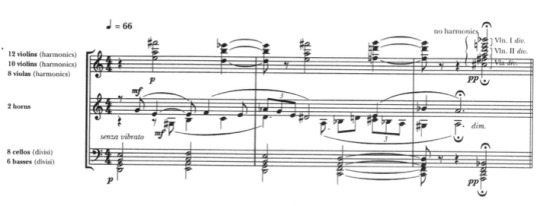
—————————————————————————————
HALF RECITAL
for my Half recital, i submitted 3 pieces out of 4. They were the;
The Bushfire, The Flood, and The Virus (2′20″)
Purple Pinkish Cotton Candy Sky (1′57″)
Full Moon (2′32″)
———————————————————————————
———————————————————————————
———————————————————————————
SEMESTER 2
WEEK 1 || Monday, 18th of January 2021
Topics:
Review semester 1
Scoring for Film, Animation, and Media
Review Semester 1
It was finally the first day of school again! at the beginning of the class, Belinda asked about what we had been doing during the holiday. I personally spent my holiday working on writing 3 shanghai jazz songs for a short film. In addition, I was arranging for lasalle’s Composer’s Concert 2021. Planning the date, concept, musicians (for my own band), and composers who are interested to showcase their pieces at the concert. —— BACK TO THE TOPIC —— Belinda mentioned that she was surprised to hear some of the works from half recital which me and my classmates did and we were happy to hear that! afterwards, the lesson started.
Scoring for Film, Animation, and Media
Finally....SCORING. One of my biggest interest in music is Film Scores. And to be honest with you, the reason i went to Lasalle and took Composition & Arranging as my stream was because i wanted to be a Film Composer. I’ve always dreamed of being one ever since i was young. So, this topic really interest me indeed. I had been looking forward for Belinda to teach this ever since the start of my day 1 studying at lasalle. “Finally... i thought.”
Here are a little summary from it;
Film Scoring — The People
The Producer: responsible for developing and nurturing the project from beginning to end. He hires the proper people, raises money, seems the film. His role is varied and straddles the administrative, financial, and creative.
The Director: responsible for envisioning and approving creative decisions. He wants the score to reflect and enhance the idea of what the film is about.
The Executive Producer: Usually the CEO of the production company. He is not in charge of the daily processes but will exercise final control over all the elements—business and creative.
The Editor: works with the director and cuts, edits his footage into a story flow. He is likely to have a good idea of how the music should fit the footage and can be an excellent liaison between composer and director
The Music Supervisor: handles the administrative part (and sometimes creative) of the music for the film/ TV program. He works with budgets, negotiated deals, hires contractors, arranges recording sessions, etc.
Film Scoring — The Screening
Go in with a notepad
Concentrate on the big picture—the overall emotional effect, the film’s effectiveness
First impressions matter—note them
Get a sense of the mood, feeling
Do not do any spotting yet
Film Scoring — Rough Cut
Establish a concept for the score
Demonstrate that concept the composer
Whilst helpful in providing the composer with a clear musical direction, they can also be a bane when the director is so used to the music that anything else will not satisfy him
Film Scoring — Style & Genre
In every style, genre of film, there is an appropriate response, an expectation, a vocabulary. These expectations are based on a precedent, a thorough study of classic films in a particular genre is essential to successful scoring. It’s not about imitation but about knowing the language and eliciting an appropriate response/reaction.
Film Scoring — Main Genres
Action
Adventure
Animation
Comedy
Crime & Gangster
Drama
Epic/Historical
Fantasy
Horror
Musicals/Dance
Science Fiction (Sci-Fi)
War
Westerns
Film Scoring — The Concept
The concept is the heart of the score. It can be discussed in terms of musical style and will form the basis of the thematic material of the film score. The composers needs to understand the central character and motivations.
There is also another dimension to scoring the character apart from scoring his/her personality, and that is, getting inside the character’s head. That dimension can chance from scene to scene, moment to moment.
On my personal note; i went to surf the internet and read more about this. After reading more about film music, i discovered that film theorists often categorize film music as diegetic or non-diegetic. Diegetic music, the music we perceive the characters can hear, is part of the story world. Meanwhile, Non-Diegetic, also called as commentary or nonliteral sound, is any sounds that does not originate from within the film’s world. Non-Diegetic music (such as a film’s title theme) narrates the film from “outside” the story world and is only audible to the audience. When Belinda mentioned about the music getting inside the character’s head, it can also be referred as diegetic music.
Back to the topic, to summarize, when talking about the concept of the film, it’s important for us the composer to know what the film is really about. Explore the characters and their themes. Often, films will have more than one dramatic theme; a personal theme and a larger overview sort of theme.
another thing to take note is that musical genres/styles are often part of a score and it is IMPORTANT to stay CONSISTENT to those styles throughout the film. Composite style (where several different stylistic elements are fused together) are also permissible but think of the appropriateness of the music to fit what is happening on the screen.
Film Scoring — The Tone
Tone refers to the attitude of the dramatic work. Whether is it dark or uplifting, etc. The composer needs to get a clear direction of tone in order to ‘assist in the storytelling’.
example: “Raiders of the Lost Ark” is a movie whose tone changes drastically from moment to moment: from humor to terror, from impending doom to a swashbuckling escape.
Checklist:
Overall dramatic theme
The central character
other themes
Time (period) / Place / Ethnic flavor
Instrumental Palette
Musical Style
Combination of styles, colors?
personal side note:
Perhaps what i understood about this is that the tone of the music is something that everything revolves around with, and in order to set the tone of the music, we need to understand the concept of the film well enough. Understanding the character, mood, and genre.
The tone can be set by things like our orchestration, instrumentation color palette (timbre), and also the techniques we use to compose like harmonic language and texture.
—————————————————————————————
WEEK 2 || Monday, 25th of January 2021
In week 2, Belinda resumed the topics from week 1. She also discussed more deeply about it. In this week, she also talked about the devices/musical techniques that we should considerate when scoring for a film.
Topics:
Scoring for Film, Animation, and Media (Part 2)
FILM SCORING — ETHNIC, PERIOD
When scoring for films with ethnic/period character, the composer needs to decide if he/she will score totally in that style, just flavored by those musical elements or not influenced by that time and place and all.
In some instances, musicological accuracy is necessary, but most situations call for a combination-approach: ethnic/historical accuracy and other harmonic/melodic language to score the drama and action.
Things to consider:
The film’s point of view
Scales, motifs, folk tunes, harmonies of that ethnicity/ time/ place
Rhythms of that ethnicity/ time / place
Instruments
There us a fine line between authenticity and stating the obvious. Avoid music clichés and other tires and overused references.
FILM SCORING — PLAYING THE DRAMA
Your audience has expectations: as a composer, you need to know what they are before you can use those expectations as tools for manipulation.
You can surprise your audience, but never betray them. Their expectations are tied closely to the function of the score and the style of the movie. The score must do what the audience expects it to do- excite them, lift them up, tug at their heart strings, make them curious, etc.
The composer knows the ending but the audience doesn’t, so it’s really important that the music never “spoils” it or gives too much away.
Whose point of view are you playing? The audience or the character?
If you are playing the audience’s POV, you’re scoring their emotional reaction. If you’re playing the character, then you’re scoring the emotional/ mental state or action that the character is in or is doing.
Main Title: The main title establishes the overall tone and setting for the movie and primes the audience’s expectations.
Dialogue: Underscoring dialogue is tricky as the composer needs to ensure that the dialogue can always be heard and understood. Where the lips can be seen, comprehensibility is easier as the audience can lip read. In instances where the lips cannot be seen, extra care needs to be exercised.
notes on Dialogue:
In general, smooth musical textures are less intrusive. Also, try to keep out of the speaking range.
Stay away from accents and distinct solo lines: allow the spoken line to be the ‘soloist’
Don’t overwrite. It’s an underscore.
MUSIC AND ITS ASSOCIATIONS
Many styles of music already have their visual and emotional associations: Gritty Jazz puts us in a big city, Gregorian chant brings us into a monastery. Use the power of musical associations to get the audience in the right place, in the right state.
for example: the film “Out of Africa” scored by John Barry has the genre of classic romance. The score is associated to the romance rather than about the period film set in Africa.
Musical Points of View
Getting inside the character
De-emphasizing the scene
Juxtaposition—playing against the scene
The minimalist approach (ex: “American Beauty” plastic bag scene by Thomas Newman
Silence
Highlighting, accenting the drama
MUSICAL CONSIDERATIONS
Now that you have a concept for the score, the next step is to translate that concept into musical terms.
The basic elements to consider are melody, harmony, rhythm, and instrumental color.
Unity and Variety
Strong scores strike a fine balance between repetition (recognition) and variety. Repetition in music can help to develop emotional power through the cumulative reactions of the audience to the repetition of a theme. With repetition, the association between the music and the characters/ situation becomes stronger.
The same theme can also be modified/ varied to suit a different setting.
Tempo/Pulse
This is the first task of the composer: to determine the pace of the scene/cue
Checklist:
Does the tempo feel emotionally compatible with the scene?
Does it provide forward motion?
Will it provide too much forward motion?
Is this a comfortable tempo for dialogue?
If the cue calls for tension, play a low repeated note with basic pulse and check if there is dramatic build-up
There are cues/scenes that require a change in pulse and tempo. The composer will need to plot a variable click in those instances.
Hitting/Catching the action
Unless the composer is scoring for cartoon/ animation, he/she will not be catching all the action. This is also known as Mickey-mousing.
The average score catches less and more subtly and often plays through the scene. Composers will score the emotional shifts in the scene, usually subtly, through entry of themes, change in colour, rhythm etc...
Composers need to analyze the scene by taking note of the shifts of emotional emphasis, shifts in action, shifts in camera angles, editorial cuts.
Beginning the Sketch:
Plot out the shifts on your sequence. Note the timings
Decide on the tempo and tempo changes. Plot the click and adjust meters accordingly.
Compose the thematic material for the cue.
Plot it into the sequence. (It may not appear at the beginning of the cue)
Check to see if the entry of the theme is compatible with the visual and shift it/ adjust it until it fits.
Write around the theme- into its entry and after it is stated.
Using the 4 basic elements of melody, harmony, rhythm and instrumental colour, finish writing the cue.
The motif is a powerful compositional tool that composers have used throughout the centuries. The motif allows the composer to write with unity and leaves him/her room for variety.
A strong motif is the key to a strong score.
Examples of strings motifs;
Beethoven’s 5th Symphony
John William’s Jaws
John Barry James Bond- Octopussy
Nino Rota Godfather- Love Theme
John Williams- Return of the Jedi- Darth Vader Theme
Bill Conti- Rocky Fanfare
HARMONIC CONSIDERATIONS
Harmonic language is the emotional palette that composers use to elicit a desired response from the audience.
Triadic shapes and traditional progressions elicit different emotions from atonal and dissonant sources. Composers need to pay attention to the tension or placidity of their harmonic choices and combinations.
Choices:
Diatonic Harmony and Chromatic Harmony
Modal Harmony
Pandiatonicism
Quartal/ Quintal harmony
Exotic/ Synthesized scales
Limited Composition, Hexachords
Polytonality
Atonality/ Serialism
Harmonic Devices:
Vertical Structures (Homophony)
Linear writing (contrapuntal writing)
Pedal points
Ostinato
Complex Texture
—————————————————————————————
WEEK 3 || Monday, 1st of February 2021
Topics:
Influence of Great Composers
17 Functions of Music in Film
INFLUENCE OF GREAT COMPOSERS
In week 3, Belinda showed us some of the most influential composers in the past that also affects film composers nowadays. Some of the composers and their pieces she discussed in the class were;
Stravinsky - “Rite of Spring”
Bartok - “Music for String instruments, Percussion and Celesta”
Orff - “Carmina Burana”
Brahms - ”Symphony No. 3, 3rd movement”
In the class we discussed and analysed about the musical devices that are happening in the pieces. like;
The melodies, lines, motives and identity, motivic development
The harmonies, harmonic devices; harmonic language as an emotional device
Rhythmic devices; rhythm as a thematic idea, uneven meter, polyrhythms
Orchestral devices; orchestration as a tool for characterization/setting, orchestration as an emotional device.
17 FUNCTIONS OF MUSIC IN FILM
1. Commenting
This is a function that shouldn’t be overdone. Music can put a judgement on certain movie scenes, it can state that a certain battle scene is heroic, a certain dialogue is sad etc.
In the early days of film music, the function of the music was most of the time to comment on the images. Nowadays we perceive this as an annoying redundancy most of the time but used cleverly it will help push the audience into the right direction.
2. Illustrating Movement
Another function that feels rather old fashioned and comedy. Accenting with the music every movement seen on screen is so-called mickey-mousing (coming from a scoring technique that was often used in Mickey Mouse cartoons). Hearing xylophone “plings” when someone raises his eyebrow etc. feels very cartoony however it can be great in slapstick moments and when done well even in dramatic situations.
3. Creating Plot Relationships
The use of so-called leitmotifs has been established by Richard Wagner in the opera and has often be used in film context since the early days of film music. Giving certain characters/situations/places thematic identities helps to connect certain plot points together.
When the villain gets a theme and later we hear that theme again when somebody talks about a “stranger” we get a very clear hint of who that stranger might be. It doesn’t need to be that obvious for leitmotifs to work, of course. However, be warned to not overdo that technique. Not every supporting role needs a motif/theme and it can quickly feel very old fashioned when using this method extensively.
4. Creating Atmosphere
This is one of the strongest function of music in the movies. It can set the tone of the movie. Just by the way the score comes in for the first time in the movie makes it possible to know the genre and the “level of drama” of the movie. Of course exactly this really strong function can be used to create plot twists.
5. Portray Emotions
Another very strong function. Music can serve the movie by getting into the emotions of the characters. A face with a neutral expression can be pushed into “feeling” many different things just by what kind of music is used. In the same way it works of course very well to evoke certain emotions with the audience.
6. Social/Cultural/Geographical references
Music can work very well to make clear the heritage of a character/group of characters or the geographic setting of the movie or a scene. Often so-called pseudo authenticity is used that uses music that feels like a certain location to western ears as opposed to actual music that can be heard at that location (which differs quite heavily sometimes).
If for example Irish sounding music can be heard during a certain scene etc. we can easily spot where it’s taking place without the need of visually establishing the location too much.
7. Time/Period references
Music can also work very well to establish a certain time or period. Music that sounds very baroque will put us back into the 18th century but references can also be more subtle. Flashbacks over a few decades for for example can be very well supported by the musical style which adapts to the time portrayed in the movie and therefore makes the flashbacks more understandable.
8. Connects scenes, montages
Music helps very well to glue scenes together. Rather harsh scene changes can be softened by adding music over the scene change. One of the extremes of these forms are montages which work beautiful with music. Even though we might have a lot of jumps in time/places or even periods, when the montage is covered under one score cue it will at the same time be glued together and understood as a whole.
9. Manipulate
One of the functions of music that is and has been used quite a lot, even though it is not one of the most noble functions of music. Doubtful contents of a movie can be pushed into the “right” direction by music as it has been seen with lots of propaganda movies from all periods of times. However it can also be used very cleverly. For example when a character that is being portrayed as “the good guy” but actually is the villain.
However in this case this fact will only be revealed at the end of the movie. Any moment before where the audience might get trapped into maybe thinking that he might be the evil guy, the music can jump in and manipulate in the way of working against these doubts.
10. Alternate the Perception of Time
The perception of time is a fantastic playground for music. Just by altering the tempo of music, it can heavily push or drag any scene. Imagine a chase sequence where the music pushed with lots of tempo, exciting orchestration etc. compared to the same sequence with a calm, slow music. The latter one would almost feel like it’s real but it would make the scene way less exciting. Same goes for any time perception. A scene where we see a person waiting which lasts only 30 seconds can be extended painfully in the perception by the music.
11. Imply a sense of space
Not only the perception of time but also the perception of space can be influenced by the music. Using a very intimate piano+violin duo on a space science fiction movie might seem just as wrong as using a full symphony orchestra in a two character movie that’s taking place in a small flat. Also by the use of register (very deep sub bass or very high violin notes as opposed to music that plays mainly in the middle registers) can leave an impression of “size”.
12. Creating unreal situations
Characterizing nightmares or situations of shock or being paralyzed can be done perfectly by the music. Anything that gives the feeling of not being real can be greatly enhanced by the music. Nightmares of characters can be made much more impressive with the right music.
13. Creating Contradictions
Music that sounds like something that is not expected in a certain scene will create a feeling of “something is not right”. It works great for example on dialogues that are actually neutral from the content of what is being said. However having a really dark and sinister music under this scene will leave the impression that something will be happening, something might be wrong here.
14. Parody
Music can influence very strongly whether we find a scene to be serious or laughable. It can use this ability to create fantastic parodies of characters or situations in the movie. One very simple example would be a character who pretends to be very evil and acts like this, however the music just gives him/her a quirky wannabe-evil march.
15. Physiological Conditioning
Music can also influence and stimulate our very basic emotions like fear and therefore evoke in a best case scenario every physiological consequence that comes with that emotion like racing heart, sweaty hands etc. Especially in the genre of horror and thriller, these effects are used extensively. A certain level of volume will make it impossible for the body and the conscious mind to detach from these emotions.
16. Implying Size Relationships
A little boy walking alone through a huge city is just a scene that might be very suitable for this use of film music. In this case the music can enlarge the visual differences between these things by giving the boy a little innocent flute motif on top of a very low, boiling music which might symbolize the huge city. In this way, things that can’t be seen like that on the screen can be set into relationship.
If this little innocent boy from above might actually be a really brave, heroic person who has done or is about to do big things the music might set him into another “size” dimension to the city even though the images don’t reveal that yet.
17. Psychologically Uniting The Audience
One of the most obvious case of such a function of music are national anthems whose function of course also is, to unite the “nation”. The same works in the music. Especially euphoric, heroic emotions can be used very effectively to get this collective emotion. Often, well known songs/music pieces can be used for that as they are easier accessible than music that the audience hears for the first time.
However, even a very heroic score cue on top of a scene where the heroes of the movie walk through a crowd applauding a cheering at them after they fought the last big battle and won can create exactly this collective feeling of having been part of all that also with the audience.
———————————————————————————
WEEK 4 || Monday, 8th of February 2021
In week 4, Belinda delve deeper into the topic she discussed briefly in week 2 about musical considerations.
Topics:
continuity from week 2—
Musical Considerations
Melodic & Harmonic Considerations
Rhythmic Considerations
Orchestral Considerations
Scoring Examples
When discussing about HARMONIC CONSIDERATIONS, Belinda showed us some examples of good scores, like;
John Williams: Star Wars- The War Reel 1 Part 3
E.T.- The Departure
Jerry Goldsmith: The Omen- The Demise of Mrs Baylock [Youtube- The Omen Pt 8, 1:05]
The Omen- Ave Satani
Michael Small: Star Chamber- Main Title
and when discussing about RHYTHMIC CONSIDERATIONS, she showed us a reference from
Omen- Altar of Sacrifice
Hans Zimmer- Man of Steel (Drums sessions) and Oil Rig, Tornado
The first reference is to showed that rhythm can be a powerful thematic idea on its own. Rhythmic ostinatos are often employed to provide drive and forward motion. Whereas the second reference showed that the percussion section can bring into the score its own color, texture, dynamics, and emotion.
things to note:
Composers should explore asymmetric meters for variety or when the cue calls for a less even rhythmic pattern.
Aleatoric rhythms (improvised) may also be explored as long as the emotional/ dramatic direction of the cue is clearly indicated to the musicians.
ORCHESRAL CONSIDERATIONS
Orchestral colour is a powerful emotional tool. After answering the initial questions: What kind of music does this need? What tempo is this?
The next most important question is: What kind of sound does this need?
Belinda discussed about the how the size of an ensembleand how it affects the sound and the mood. She also gives reference of different scores with contrasting orchestration palette. some of them were;
Vangelis- Chariots of Fire
Daft Punk- Tron Legacy (Mixed- electronic and
Orchestral)
Trent Reznor (Nine Inch Nails) & Atticus Ross- The Social Network
things to take note:
A change in orchestral colour will cause an emotional/ dramatic shift.
A theme can take on different meanings with different orchestration treatments.
Apart from typical idiomatic colours, there are also special effects and extended techniques that can be employed today to inject drama and emotion in new and fresh ways.
The best way to learn how to orchestrate is to study orchestral scores of the Masters, especially the scores of the Romantic and Late romantic composers.
Pay attention to their use of colour, balance, weight, span, sonority, transparency and other orchestral devices.
———————————————————————————————————
Week 5 || Monday, 15th of February 2021
First of all, i was excited for the lesson by seeing the topics list that Belinda showed before the class. Because Neoclassicism has always been apart of my writing style and i draw a great amount of inspirations from the Neoclassicism composers, especially William Schuman. Although Belinda has taught us in Year 2 about this and mentioned it quite a few times, but it was a very good refresher to learn about this again and listened to her explaining about it.
Topics:
Neoclassicism
Score Analyses:
- Stravinsky: Symphony in C - Hindemith: Mathis der Maler - Schuman - Symphony No.3
NEOCLASSICISM
basic Information:
A return to ‘Classicism’- to clarity, order, balance, economy, and emotional
restraint.
A reaction to the emotional excesses of Romanticism and dissonance of atonal 20th Century musical movement.
Emphasis on form, rhythm, contrapuntal texture, updated/ expanded harmony
Started between the 2 world wars- 1923 to1950
Composers & Works
Pulcinella — Stravinsky
Symphony in C — Stravinsky
Mathis der Maler — Hindemith
Appalachian Spring — Aaron Copland
Symphony No.5 — Prokofiev
Symphony No.3 — Roy Harris
Symphony No.3 — William Schuman
Menu of Compositional Devices
Common Practice Tonal Centres — Major and Minor
Chord Extensions — 9ths, 11ths, 13ths, and alterations
Added note chords
Chromaticism and Tonal Ambiguity
Meter-Mixed and Asymmetric Meter
Modes and other scale sources, including Synthetic scales
Polyharmony— polytonality and polychords
Non-tertian Harmony — Quartal and Quintal
Scandal Chords — clusters
Parallelism
12-tone Technique and Serialism
Limited Composition — based on intervals
Hexachord Writing
Unrelated Triads
Mirror Writing
Harmonic Direction — progression, cadential devices
Harmonic Synthesis
Indeterminate Procedures
Noise, Sound, and Electronic devices
Extended Techniques
Texture
Microtones
SCORE ANALYSIS
my thought:
I loved the examples that Belinda showed. But my favorite would be Roy Harris’s Symphony No.3. Belinda showed us this technique called “micropolyphony” or actually complex texture. There’s this section from the piece at timecode 7:00 (in youtube) where Harris used the micropolyphony and it sounded beautiful. Although every part plays different notes, but the section just sounded beautifully because their parts shared the same pitch classes. After learning about this technique, I straightly have an idea to use it in one of my recital pieces “The Rain and The Rainbow”. To feature it in the Rain part.
———————————————————————————————————
WEEK 6 || Monday, 22nd of February 2021
This week, Belinda taught us the importance of analysis and how you can benefit greatly from it. I totally agree with the idea of analysis. Whenever i writing something, usually i would always draw and idea from a music that i like. After listening to the music, usually i would transcribe the section that i like then i always learn something from it. In a way i also analyzed it. Even though only in a small chunk, but i benefit so much from it.
Topics:
Analyses: What are you looking for? What are you looking at?
Texture & Timbres
WHY ANALYSE
You’ve heard of the phrase/ method, “reading to write”, which refers to the practice of reading for the purpose of becoming a good writer.
There is an equivalent in music, and that is, analysing scores for the purpose of becoming a better composer.
We begin by developing the habit of listening to good music, and allowing the music to open our ears to good compositional and orchestral devices.
We learn/ imbibe a lot through ‘osmosis’, through a process of immersion. If we immerse ourselves in good music, some of that inspired style and musical eloquence may just seep into our subconscious.
With the score, we then apply analytical skills to better understand how the parts work together to make up the beautiful whole.
A good method for analysis is the ‘Funnel Method’- by starting with the big ideas, broad strokes first, then working through the piece with greater specificity and detail.
A good place to start is the concept of the composition, the purpose or intention for the piece.
Form and structure would be the next logical parameter for analysis: sectional form, phrasal structure and transitions.
Thematic analysis, primary and secondary materials, development and variation would be next.
Texture and Density would follow.
Orchestration, timbre, orchestral devices should be examined.
Rhythm, Meter, Articulation and other devices associated with movement, momentum should be examined.
At all times, dynamics and emotional contour should be observed and all the elements mentioned above taken into consideration.
Don’t forget to ‘pull back’ and take note of the balance of unity and contrast in the composition.
How does the composer achieve cohesion in this piece?
Is the piece comprehensible? If so, how does the composer achieve this comprehensibility?
Annotate, annotate, annotate.
Take note of first impressions and latter impressions.
Compare your analyses with others, share and compare notes.
Listen to various recordings/ conductors you can glean different things from different interpretations
Make a note or make sketches of ideas you can ‘borrow’
TEXTURE & TIMBRES
Texture is the combinations of pitch, timbre, and rhythm
Common categorization of texture: Homophony, Polyphony & Complex
Considerations:
Harmonic/scalar language
Density
Intervallic Relationships
Belinda showed us examples of different textures from different pieces. My favorite of the Micropolyphony examplewould still be in Roy Harris’ Symphony No.3 (timecode 7:00 on youtube).
—————————————————————————————WEEK 7 || Monday, 1st of March 2021
Topics:
Debrief — Composers Concert
Character, Mood, and Emotion
DEBRIEF — COMPOSERS CONCERT
Belinda talked about what went well and not from our Composers Concert 2021.
notes:
As of my piece “Mrs. Puss” that was performed, Belinda told me that the Violin in the piece was quite soft whereas it supposed to be louder since it played some lead lines. I agreed to that, however it wasn’t because of the playing, but was because of the sound that was coming out from the speaker that the audience heard. To me (as the musician who also played together in the band), the Violin sounded okay from my perspective. I was hoping that that they will adjust that in the mixing post-production.
Khushi and Matt also had the same issue with the balancing. But really it was more of the mixing.
Another issue that they were facing was muddiness.
As of the other pieces (string quartet), Belinda referred many of it to be not-so cohesive and comprehensible. and that is one of the key takeaway that we can learn from. The solution lies in the composer himself actually.
Belinda told us that when a piece is cohesive and comprehensible, you won’t notice it, but when it is not then you’ll notice that. I understood what she meant and that’s what i also felt like when hearing the pieces for the first time in the google drive that was shared to me.
A few miscommunication between me and my other peers. Can be improved.
Otherwise, it was a quite successful show. Now just waiting for the release date!!!
regarding the issues that we had (compositionally), Belinda gave us notes about a few things which we can learn and apply it when we’re writing for our pieces for our final recital;
FOCUS & DIRECTION
Intentionality
Focal line(s), focal sound?
Unity (the constant) vs Contrat (variation) beyond the structural, the vamp, the progression. Where are you taking the listener?
Emotional Contour — shape and climax(es)
Pace—maintaining and building momentum
ARTICULATION, DYNAMICS, AND EXECUTION
Ensemble playing & hits:
Accents — the long & short of it
Communication & Tightness
Contrast hits with flow, unison with open voicings
Tight with dynamics, play with changing dynamics
Contrat quick passage with space and breath
regarding communication and tightness, Belinda also critique about my band’s articulation. She told me that my double bassist in the band (Eugene) seemed to be the only who gave the correct articulation whereas the others are too focused in playing the right notes. I mean, playing the right notes is crucial, but afterwards you should learn how to enjoy the song. Honestly, i head bopping and trying to enjoy the piece too, but i guess its true that i was still too afraid to play wrong notes and my gestures was too small. And i guess hm my head bopping was some sort of....hmm..how should i say it.. only gimmick? and perhaps that showed too.
VERTICALS & SONORITY
Pay attention to register- close intervals at lower registers will sound muddy
If the verticals are ‘hot’, it will sound muddier!
Use polytonality with intention & caution. Control dissonances, voice appropriately.
Combine familiar shapes (e.g. triads & quartals) to construct polyharmonies
FORM
The most complex of compositions can be comprehended if FORM is apparent
Pay attention to constructing clear sections (that flow/ transition cohesively)
Pay attention to building & developing motives/ themes: maintaining unity, yet creating diversity/ contrast
important questions:
What am i saying?
How am i saying it?
Finally, Belinda linked it to the lesson——————
CHARACTER, MOOD, AND EMOTION
Music and extra-musical associations
Clarity of expression
Tools:
Melodic line(s)
Harmony/ Verticals
Texture
Orchestral color & devices
All about sound:
The overtones series-consonances and dissonances
Melodic and motivic ideas: steps, skips, and leaps
Intervallic tendencies
Melodic Shape and Contour
Phrasing, Cadences, and Breath
Primary, Subsidiary
Harmonic Language—
Tonality (poly, neo)
Atonality, Key/Mode Colours
Chord/Vertical Colours
Rhythm—
Pulse, Tempo, Natural rhythms
Momentum
Duple/Triple and Asymmetric Meter
Subdivisions, Triplets
Orchestration—
Orchestral Colors
Orchestral Devices
Orchestral Elements and Texture
Form and Structure—
Organization
Development
Sense of Unity
Recognition, Logic, Cohesion, Comprehensibility
FINAL RECITAL
finally Belinda briefly talked about our Final Recital and some checklists;
String Quartet
Wind Quartet: Flute, Oboe, Clarinet, Bassoon
Optional: laptop playback
Possible Combinations:
Full ensemble + Laptop playback
String Quartet
Featured Wind(s) with Strings Quartet
Featured String with Wind ensemble
—————————————————————————————WEEK 8 || Monday, 8th of March 2021
NO LESSON.
—————————————————————————————
WEEK 9 || Monday, 15th of March 2021
Topics:
Key Centers/tonal Centres
Shifting Tonalities
Neotonality
KEY CENTRES
There are many degrees of key center gravity or keylessness
Apart from chordal progression, melodic direction, repetition of notes and instrumentation can suggest/emphasize tonality
MODULATION
The concept of Modulation is based on the relatedness of any chord to any of the 12 tonal centers.
‘Traditional modulations’ are based on pivotal chords.
‘Less traditional modulations’ may be abrupt parallel shifts or based on looser pivots, such as pivot notes and then softened by voice-leading.
POLYTONALITY
Be careful that the combined effect does not produce a haphazard sound. The music must be conceived in polytonal context and not sound accidental.
The composer needs to work this in a ‘total organization’ framework, paying attention to tonal planes.
The Harmonic total must have a sense of direction, flow, tension design and textural consistency.
Use spacing, register, texture and omission to create clarity and avoid muddiness.
examples of displaced tonality;
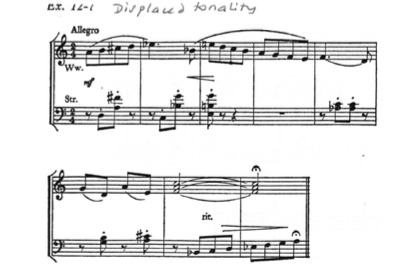

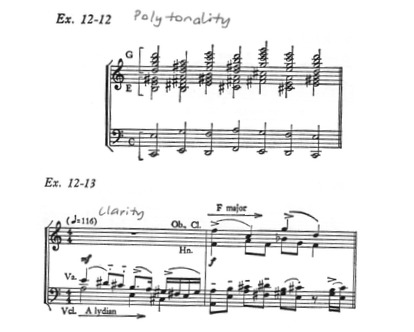
SERIAL HARMONY
The choice of notes in Serial Harmony are either dependent on the row (Total Organization) or include endless possibilities if the method of serial composition is less strict.
Intervallic relationships: consonances and dissonances are important factors in deciding how verticals are formed.
Melodic direction, voice-leading and texture also determine the overall effect of sonorities.
Motivic/ thematic features support cohesion and comprehensibility.
Rhythmic features and articulation are prominent characteristics.
examples of serial harmony;
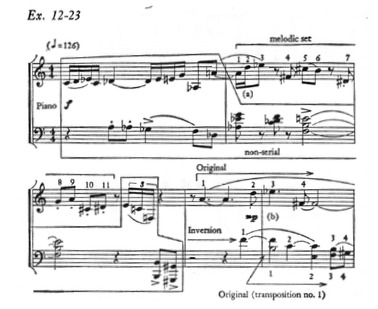
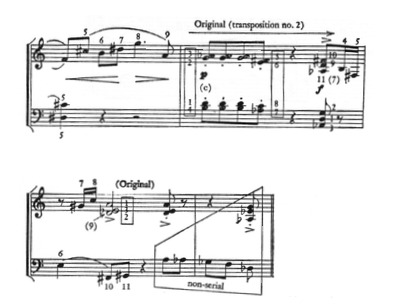
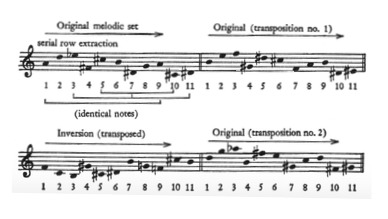
NEOTONALITY
Tonality that is not based on any particular diatonic system nor functional harmony (Common Practice Period)
Features non-traditional concepts such as tonal assertion or contrapuntal movement around a tonal centre (which may shift).
Combining the features of Common Practice Period tonality with 20th Century tonal ambiguity and atonal characteristics
Neotonal Composers
Stravinsky
Bartok
Kodaly
Janacek (maleva likes him)
Vaughn Williams
Prokovief
Shostakovich
Hindemith (maleva likes him too)
Samuel Barber
Villa-Lobos
Ginastera
William Schuman (MALEVA’S FAVORITE)
Roy Harris
William Walton
personal note:
on my personal note, i listen to these composers during my free time. and i found my pieces that really interest me. Some even has become my own personal “temp track” for my recital pieces! for example; Janacek’s “The Cunning Little Vixen: II. Allegro” was my inspiration when writing my piece “Purple-Pinkish Cotton Candy Sky” and “Full Moon”. Other than Janacek, I also took great inspiration from pieces from William Schuman, and others! Don't believe me?? Look at my SPOTIFY PLAYLIST!!! i legitly made playlists for each of the pieces that i want to write. I collect pieces that inspires me the most and built my creativity based on that.
maleva’s playlists for “Purple Pinkish Cotton Candy Sky”;
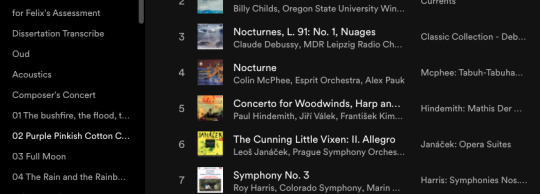
maleva’s playlists for “Full Moon”
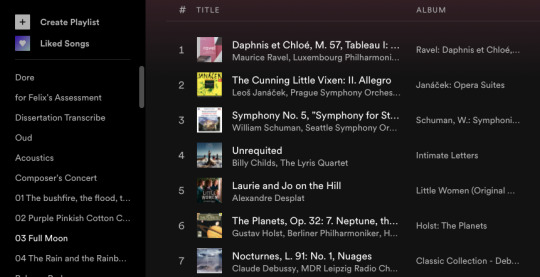
BACK TO THE LESSON;
at the end of the class, Belinda finalised the instruments that we will be having for our recital and remind us again regarding some checklists.
—————————————————————————————
WEEK 10 || Monday, 22nd of March 2021
This week’s class was so interesting, as we dissected the piece of our own BELINDA titled JOB
Topics:
Deconstructing JOB — A Symphonic Dance
Thinking timbrally
JOB — A SYMPHONIC DANCE
form
narrative driven
Dance form
“Through-composed”
Thematic thread
sections in order;
Parade of the Celestials
Gigue of the Adversary
The Challenge
Sabean Attack
Chaldean Attack
The Wind-Collapse-The Sores-Job’s Wife’s Curse
Sitting in Silence
Duet (Dialogue 1)
Dialogue2
Dialogue 3
The Whirlwind
My Eyes Sees Thee
Repent and Retract
Coda-Allegretto
THINKING TIMBRALLY
Wind Quintet & String Quartet configurations
Woodwind
Individual characteristics-flutey, reedy, hollow
Combines timbres
Dove-tailing
Spacing
Register and Dynamics
Harmonic balance
Unison and Doublings
Strings
Individual characteristics
Spacing
Harmonic balance
Register and Dynamics
Unison and Doublings
Combinations
Timbral combinations
Oboe & Cello
Bassoon & Cello
Flute and French Horn
Solo Wind with Strings
Solo Strings with Wind Ensemble
Contrapuntal, mul-timbral applications
Textures: harmonic textures, contrapuntal streams
Percussion & Miscellaneous
Definite and Indefinite pitch writing
Accents, shimmer, highlights, weight
As a features instrument
Orchestration Principles
Balance: feature, main, secondary...
Dynamic and emotional contour
Clarity
Span, register
Weight, Float
Interest
Momentum
Readability
—————————————————————————————
WEEK 11 || Monday, 29th of March 2021
Topics:
Review Form
Analyze Stravinsky’s Babel
Analyze Schwanter’s Aftertones of Infinity
FORM
Binary Form: A B
Ternary Form: A1 B A2
Sonata Form;
Exposition: 1st Subject/ Transition/ 2nd Subject/ Codetta
Development
Recapitulation: 1st Subject/ Transition/ 2nd Subject/ Coda
Simple Rondo Form: A1 B A2 C A3
Rondo-Sonata Form
Exposition: 1st Subject/ Transition/ 2nd Subject/ 1st Subject
Development
Recapitulation: 1st Subject/ Transition/ 2nd Subject/ 1st Subject/ Coda
Theme and Variation: featuring a main theme followed by altered iterations
Passacaglia: A series of variations over a basso ostinato
STRAVINSKY — BABEL
texture and density
Ostinato
Verticals
Chorale treatment
Narrative-Form
Momentum and Motion
SCHWANTER — AFTERTONES OF INFINITY
** i think this piece is amazing. Belinda also mentioned that this piece won a Nobel prize! there were a few things to take note of like;
Shimmering musical timbres
Layers of Sound
Protoset: C#-A-F-Gb-C-B-Ab-Eb-D
Predominant intervals
can be watched from here;
https://www.youtube.com/watch?v=Sns6KLvrb_o
—————————————————————————————
WEEK 12 || Monday, 5th of April 2021
Topics:
Review Compositional Devices
Analyze Toru Takemitsu’s A Flock Descends into a Pentogonal Garden
COMPOSITIONAL DEVICES
Common Practice Tonal Centers- Major and Minor
Chord Extensions- 9ths, 11ths, 13ths and alterations
Added note chords
Chromaticism and Tonal Ambiguity
Meter- Mixed and Asymmetric Meter
Modes and other Scale sources, including Synthetic scales
Polyharmony- polytonality and polychords
Non-tertian Harmony- Quartal and Quintal
Secundal Chords- clusters
Parallelism
12-tone Technique and Serialism
Limited Composition- based on intervals
Hexachord Writing
Unrelated Triads
Mirror Writing
Harmonic Direction- progression, cadential devices
Harmonic Synthesis
Indeterminate Procedures
Noise, Sound & Electronic devices
Extended Techniques
Texture
Microtones
TORU TAKEMITSU
Belinda mentioned how amazing that Takemitsu — although his music is very modern, but he would always never lose his Japanese touches in his music. Belinda also mentioned us about the importance of having a signature sound in our music. And it’s good if we can feature our own identity like where we come from for example.
Takemitsu’s music:
Straddled “parallel music cultures.”
Bi-musicality in modern Japanese culture: mixture of Western music with traditional Japanese music
In this piece, he uses the pentatonic scale (called the yo scale in Japanese.)
TORU TAKEMITSU — A FLOCK DESCENDS INTO A PENTOGONAL GARDEN
Clustered verticals
Silvery glisses
Lyrical melodies
Metallic, bell-like textures
Pentatonic base: C#- Eb- F#- Ab- Bb
Belinda also showed us some examples of some Contemporary String Quartets pieces;
String Quartet No. 2, "musica instrumentalis": III. Double Triple Gigue Fugue- by Aaron Jay Kernis, performed by Jasper String Quartet
link: https://www.youtube.com/watch?v=Y1dxsWGrtzQ
String Quartet No. 1, Op. 8: IV. Fugue- by Alan Hovhaness, performed by Shanghai Quartet
link: https://www.youtube.com/watch?v=VTQmztjK_2g
Love letters for String Quartet by Carter Pann, performed by Ying Quartet
link: https://www.youtube.com/watch?v=ER0faKEz0Ss
my personal note;
The “Love Letters” by Carter Pann was my personal favorite and i even listened back to it after the class ended.
—————————————————————————————
WEEK 13 to WEEK 16
throughout these weeks we had no more lessons but more consultation for our final recital.
0 notes
Photo

Retrofuturism. Hypersexuality. Virtual Reality. Apocalypsis. . MUA.@saradashty Fashion design and styling.@hec_manuel Capture at @ilanioproject studios Production.@e801 . 📽🎬💥💨 By @warrendifranco for @ModaCineFilms • • • • • DM for inquiries 👈👈 (at Los Angeles, California) https://www.instagram.com/p/BoDHM9gAm5G/?utm_source=ig_tumblr_share&igshid=3ismux3rxz27
0 notes